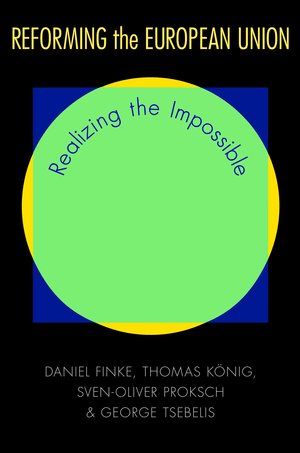 For decades the European Union tried changing its institutions, but achieved only unsatisfying political compromises and modest, incremental treaty revisions. In late 2009, however, the EU was successfully reformed through the Treaty of Lisbon. Reforming the European Union examines how political leaders ratified this treaty against all odds and shows how this victory involved all stages of treaty reform negotiations–from the initial proposal to referendums in several European countries. An engaging read for students, finds Mareike Kleine.
For decades the European Union tried changing its institutions, but achieved only unsatisfying political compromises and modest, incremental treaty revisions. In late 2009, however, the EU was successfully reformed through the Treaty of Lisbon. Reforming the European Union examines how political leaders ratified this treaty against all odds and shows how this victory involved all stages of treaty reform negotiations–from the initial proposal to referendums in several European countries. An engaging read for students, finds Mareike Kleine.
 Reforming the European Union: Realizing the Impossible. Daniel Finke, Thomas König, Sven-Oliver Proksch, George Tsebelis. Princeton University Press. July 2012.
Reforming the European Union: Realizing the Impossible. Daniel Finke, Thomas König, Sven-Oliver Proksch, George Tsebelis. Princeton University Press. July 2012.
Power, Steven Lukes teaches us, has three dimensions. The first dimension becomes apparent in open conflicts when one actor is capable of making other actors do something that they would not otherwise do. Considering non-decisions as likewise important, the second dimension adds procedures to the picture. Institutional rules “mobilize bias” in that they prevent certain decisions from being taken on issues over which there is a conflict of interest. The third dimension considers social forces such as norms and persuasion that shape actors’ perceptions and preferences in such a way that they accept their role in a consensual order of things.
Reforming the European Union is a powerful endorsement of the second dimension, and as such presents the most sophisticated rational-choice institutionalist analysis yet of EU treaty revisions. It is motivated by the following puzzle: where previous reforms attempts yielded unsatisfactory outcomes on the lowest common denominator (Nice), the reform process this time resulted in a surprisingly ambitious treaty (Lisbon). How is this possible?
Reforming the European Union provides a compelling answer: “The key to our understanding of the successful revision of the Treaty of Nice,” the authors maintain, “lies in the modification of the rules of the treaty revision game.” Where previous reforms relied on decentralized bargaining at intergovernmental conferences, the reform process this time included several stages, the most important of which was the Constitutional Convention whose ambitious proposal for a Constitutional Treaty set the agenda for subsequent intergovernmental negotiations.
The book’s seven chapters analyze each step of this reform process, beginning with the Constitutional Convention, its subsequent amendment in intergovernmental meetings and, finally, the ratification of what is now the Treaty of Lisbon. After nearly 200 pages of intriguing and sophisticated analyses, the authors conclude inter alia (1) that despite some unintended consequences political leaders acted strategically throughout the reform process and (2) that the focus on preferences and procedural rules is essential to our understanding of this process.
No student of current debates in EU studies will find any of this novel – not least because the authors themselves have significantly shaped these debates. The original contribution lies instead in the analysis of the reform process itself. The authors marshal an impressive range of sources to compile a unique data set about the preferences of Convention delegates, national parliaments, political leaders, and voters. A second and related contribution is that the authors employ a number of sophisticated techniques in their analyses of these data.
One might disagree with the precise measurement of preferences, especially when it comes to the distinction between sincere preferences and their strategic presentation. But these debates have been fought out in length elsewhere. Instead, I think that the authors should be applauded for the painstaking effort of compiling this impressive data set. Indeed, Reforming the European Union serves as a model and must be considered the reference for all students of treaty reforms.
No book is without weaknesses, however. Reforming the European Union is no exception to this rule. As an updated collection of separately conducted studies, it features some of the shortcomings that are common to edited volumes. Reaching the final pages, the reader is left with the sense that the holistic effort to study the entire reform process adds up to less than the sum of its parts.
But the big picture also fails to emerge in full, because the authors neglect to engage alternative explanations for the striking success of the reform process. Absent from the discussion are Luke’s first and third dimension of power: power as capacity and power through social forces. As a result, the interpretation of evidence appears somewhat reductionist.
Let us begin by asking why the Constitutional Treaty set the agenda for the subsequent intergovernmental conference to begin with? Previous conferences, too, had been prepared by various committees. Of those preparatory bodies, only the Constitutional Convention established its results as a blueprint for subsequent negotiations.
The first dimension of power as the capacity of making actors do what they would otherwise not do might offer an answer to this question. As the authors establish, the Constitutional Treaty with its new voting formula greatly benefits large states, and Germany in particular. The book claims that it was a lucky coincidence that Germany held the Presidency when small states openly questioned the constitution’s focal-point character. Perhaps more fortunate, one might add, is the fact that Germany is a large and economically powerful country that can compel smaller countries to acquiesce to what they would not otherwise accept.
The third dimension of power as a social force is also somewhat treated like a red-headed stepchild. Again, the question of why the Constitutional Treaty became a focal point serves as an example. In contrast to previous treaty negotiations, this reform process was couched in constitutional rhetoric and symbolism. One might argue that the Constitutional Treaty became a focal point because it is difficult to neglect a document with the term “constitution” in its name. This argument might also explain the unusually high number of referendums: once the importance of a treaty is signified with the label “constitution”, it is difficult to deny demands for a popular vote, especially once other political leaders have announced a referendum with exactly this argument.
In sum, the book would have benefited from a more nuanced engagement of alternative perspectives on treaty revisions. This omission is regrettable, above all, because the authors miss a unique opportunity to marshal evidence in what could have been a major contribution to the debate about institutional change. International organizations worldwide have been criticized for their inefficiency and lack of accountability. Apart from implying that states should change the way they negotiate, the reader is left wondering how the book’s findings are applicable beyond Europe.
These quibbles, however, cannot deflect from the fact that this is a smart, sophisticated analysis that contains much to admire. Reforming the European Union is a great book that all students of EU treaty revisions will have to read and engage with.
——————————————————————————————-
Mareike Klein joined the European Institute in September 2009 as a Lecturer in EU Politics. Her research interests include-theories of international organisation and International Political Economy, informal and formal governance, the interplay of domestic politics and international institutions, negotiation theories and normative questions of global governance. Her book on informal governance in the European Union is forthcoming with Cornell University Press. She has also published various scholarly and policy articles on these topics. Read reviews by Mareike.






